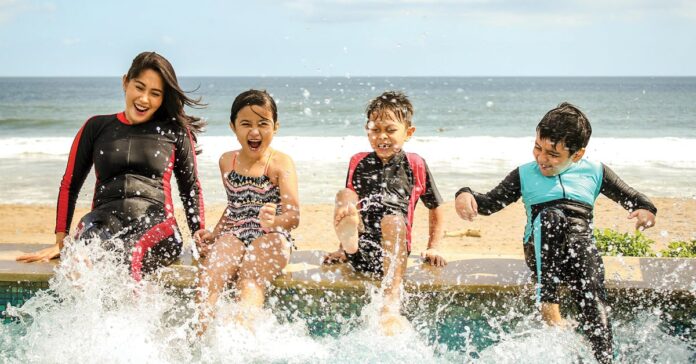
Sun and Heat Protection
- Sunscreen
- Hat
- Sunglasses
- UPF/SPF clothing
- Water
Make sure kids are slathered in sunscreen with an SPF of 30 or higher, covering every inch of exposed skin, from their ears and scalp to the tops of their feet and backs of their hands. Don’t forget to reapply every two hours.
Shi-Ying suggests using lotion over spray to ensure optimal sun protection. “When using sunscreen in the form of a spray, it is hard to evenly apply to the skin, and it gets more in the air than our skin,” says Shi-Ying. “Lotion is best when applying on the face, to avoid possible inhalation from sprays. When there is only spray available, it is recommended to spray the lotion on your hands then apply to our child’s skin.”
Shi-Ying also notes that dressing small children in clothing with UPF and SPF can help as an extra layer of caution.
In addition to the skin, eyes can also become sunburned. Sunburned eyes become red, dry, painful, and feel gritty, and can have long-term effects on vision. “Protect your child’s eyes by choosing sunglasses with UV protection and a wide-brimmed hat,” says Shi-Ying.
Staying hydrated is also imperative while spending time in the sun. In warm summer months, Shi-Ying suggests drinking at least 1 cup of water for each hour spent outside to prevent heat exhaustion and dehydration.
Water Safety Gear
- Life jacket
- Swim diapers for small children
- Towel for drying ears and preventing swimmer’s ear
Swimming in the ocean, lakes or rivers is very different from swimming in a pool. Waves, currents, and winds can drain the energy and strength of even the strongest of swimmers.
Before you and your child decide to go for a swim, it’s important to consider whether your child needs a life jacket. Properly fitted US Coast Guard-approved life jackets provide the highest level of floatation. Under California law, children under 13 years old must wear a Coast Guard-approved life jacket on a moving recreational vessel of any length. These laws can vary by state so be sure to check for local and state guidelines, including swimming advisories and water quality notices before your trip.
After swimming or playing in the sand, dry ears thoroughly to help prevent swimmer’s ear and be sure to wash hands for 20 seconds or rinse off in a sink or shower before and after being in the water. Caretakers of small children should also be sure to pack swimming approved diapers and change them every hour. Swimming-related illnesses most commonly include diarrhea, skin rashes, swimmer’s ear, pneumonia or flu-like symptoms, and irritation of the eyes or respiratory tract.
Bites and Stings Protection
- Insect repellent
- First aid kit
While at the beach, it’s important to take steps to avoid bug bites and stings from marine animals such as jellyfish. These stings and bites can cause pain, burning, swelling, redness, bleeding, cramps, diarrhea, difficulty breathing, and fever. Some stings and bites can even be deadly.
To prevent bug bites and stings, use an EPA-registered insect repellent. Always apply sunscreen first, let it dry, then apply insect repellent. When providing first aid for stings or bites, wear gloves and wash the site with soap and water. For stings caused by a stinging insect (bees, wasps, hornets, and fire ants), remove the stinger using either gauze or by quickly scraping a fingernail over the stung area. It’s important not to squeeze the area or use tweezers. Once the stinger is out, apply ice to bring down swelling and try to avoid scratching the area. For those interested in reef and ocean bug sprays, you can find additional resources on ingredients to look out for on oceanservice.noaa.gov.
Key Takeaways
If you are going to take a trip to the beach this summer with your family, be sure to bring:
- Sunscreen and sun safe clothing to help prevent sunburns and heat-related illness
- Swim safe diapers and US Coast Guard-approved life jackets for water safety
- EPA-registered insect repellent to prevent bug bites and insect borne diseases
If you are concerned about summer safety for your little ones, schedule an appointment with your pediatrician. Our “Find a Doctor” tool can help you find a Dignity Health physician near you.


